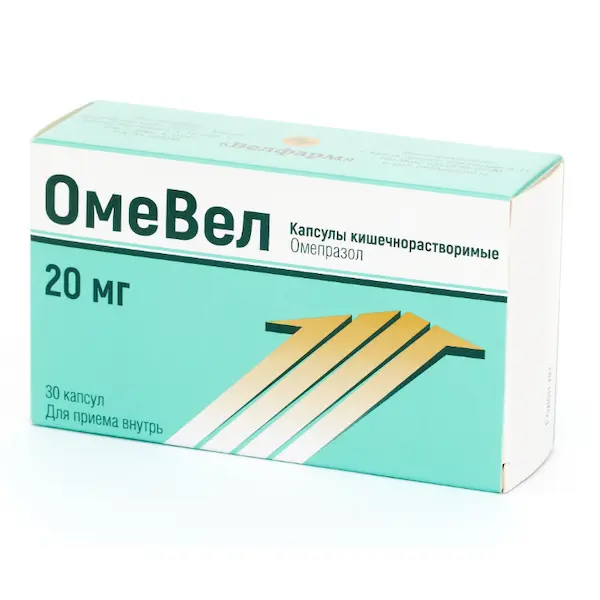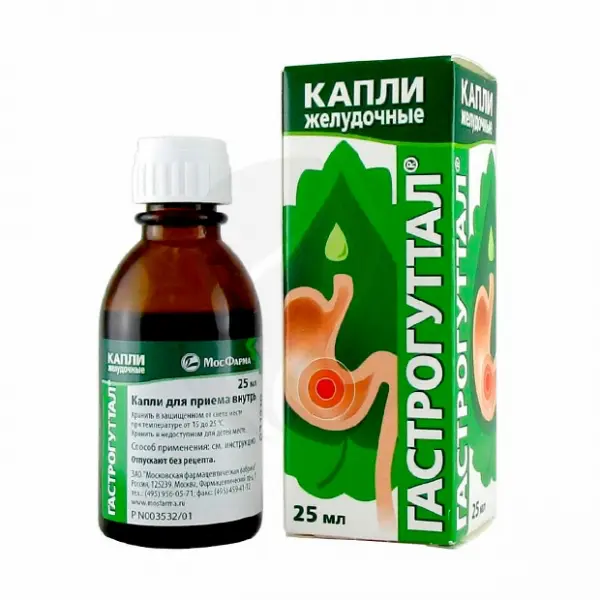Description
OmeVel Pharmacodynamics
Omeprazole is a racemic mixture of two enantiomers, reduces hydrochloric acid secretion by specific proton pump inhibition of gastric parietal cells. When administered once, it is fast acting and has a reversible inhibition of hydrochloric acid secretion.
Mechanism of action
Omeprazole is a weak base, converts to its active form in the acidic environment of the tubules of the cells of the parietal layer of the gastric mucosa, where it is activated and inhibits the H+/K+-ATPase of the proton pump. It has a dose-dependent effect on the last stage of hydrochloric acid synthesis and inhibits both basal and stimulated secretion regardless of the stimulating factor.
Effects on hydrochloric acid secretion in the stomach
After oral administration of omeprazole once daily, there is a rapid and effective decrease in daytime and nighttime hydrochloric acid secretion, which reaches a maximum within 4 days of treatment.
In patients with duodenal ulcer the use of 20 mg omeprazole causes stable reduction of 24-hour gastric acidity by at least 80%. At the same time a decrease in the average maximum concentration of hydrochloric acid after pentagastrin stimulation by 70% is achieved within 24 hours. Daily oral administration of 20 mg of omeprazole in patients with duodenal ulcer maintains acidity at pH > 3 for 17 hours on average.
The degree of inhibition of hydrochloric acid secretion is proportional to the area under the concentration-time curve (AUC) of omeprazole and is not proportional to the actual blood concentration of omeprazole at a given time. No tachyphylaxis has been observed during treatment with omeprazole.
In vitro omeprazole has a bactericidal effect on Helicobacter pylori. Eradication of Helicobacter pylori when using omeprazole together with antibacterial agents is accompanied by rapid elimination of symptoms, a high degree of healing of gastrointestinal mucosal defects and long-term remission of peptic ulcer disease, which reduces the probability of complications such as bleeding as effectively as continuous supportive therapy.
As a consequence of decreased hydrochloric acid secretion, the concentration of chromogranin A (CgA) increases. An increase in CgA concentration can affect the results of neuroendocrine tumor screenings. To prevent this effect, omeprazole should be temporarily discontinued 5 days before the CgA examination.
Indications
Adults:
– Gastric and duodenal ulcer (treatment and prevention);
– Eradication of Helicobacter pylori in peptic ulcer disease of the stomach and duodenum (as a part of combined therapy);
– NSAID-associated ulcers and erosions of the stomach and duodenum (treatment and prevention);
– reflux esophagitis; symptomatic gastroesophageal reflux disease (GERD);
– Dyspepsia associated with hyperacidity; Zollinger-Ellison syndrome;
Children over 2 years of age, with body weight greater than 20 kg:
– In GERD therapy;
Children over 4 years of age, with a body weight greater than 20 kg:
– Helicobacter pylori eradication in duodenal ulcer disease (as part of combination therapy).
Safety and efficacy in other indications in pediatric patients have not been established.
Contraindications
Hypersensitivity to omeprazole or any of the drug components; fructose intolerance; sucrose/isomaltase deficiency; glucose-galactose malabsorption; simultaneous use with clarithromycin in patients with liver failure; atazanavir, St. John’s wort, erlotinib, posaconazole.
The use of omeprazole in children is contraindicated except for GERD indications for children over 2 years of age and for treatment of duodenal ulcer caused by Helicobacter pylori for children over 4 years of age. Childhood under 18 years of age (for all indications except reflux esophagitis and Helicobacter pylori eradication for duodenal ulcer).
With caution: Insufficient liver function; renal insufficiency, osteoporosis, concomitant use with clopidogrel, digoxin, ketoconazole, itraconazole, warfarin, cilostazol, diazepam, phenytoin, saquinavir, tacrolimus, clarithromycin, voriconazole, rifampicin, preparations of St John’s wort, significant spontaneous weight loss, recurrent vomiting, vomiting with admixture of blood, impaired swallowing, discolored stools (tarry stools), and also in the presence of stomach ulcer (or at its suspicion) before the beginning of treatment malignant tumor should be excluded, because the treatment can lead to masking of symptoms and delay the establishment of the correct diagnosis.
Use in pregnancy and during breastfeeding:
Studies indicate no adverse effects on pregnancy, fetal or newborn health. Omeprazole may be used with caution during pregnancy.
Omeprazole is excreted with breast milk. However, when used in therapeutic doses, effects on the child are unlikely.
Dosage and administration
- Duodenal ulcer
- With an exacerbation of duodenal ulcer, it is recommended to take the drug 20 mg 1 time per day. Usually the therapy duration is two weeks, if necessary, it is possible to increase the course of therapy for 2 more weeks. Patients with duodenal ulcer resistant to treatment are usually prescribed the drug 40 mg once a day, for 4 weeks. For relapse prevention in patients with duodenal ulcer disease, 20 mg once daily. If necessary, the dose can be increased to 40 mg once a day.
- Peptic ulcer
- With an exacerbation of peptic ulcer disease, it is recommended to take the drug in 20 mg 1 time per day. Usually the duration of therapy is 4 weeks. If after the first course of the drug complete healing does not occur, a repeated 4-week course of treatment is prescribed. Patients with gastric ulcer resistant to treatment are usually prescribed the drug 40 mg once a day, healing is usually achieved within 8 weeks. For prevention of relapse in patients with peptic ulcer disease, 20 mg once daily. If necessary, the dose can be increased to 40 mg once daily.
- Regimens of eradication, Helicobacter pylori in peptic ulcer disease: omeprazole 20 mg, clarithromycin 500 mg, amoxicillin 1000 mg simultaneously 2 times daily for 1 week; omeprazole 20 mg, clarithromycin 250 mg (alternatively, 500 mg), metronidazole 400 mg (or 500 mg or tinidazole 500 mg) simultaneously 2 times daily for 1 week omeprazole 40 mg once daily, and amoxicillin 500 mg with metronidazole 400 mg (or 500 mg or tinidazole 500 mg) both 3 times daily for 1 week.
- In cases where the patient is Helicobacter pylor-positive after treatment, a second course of treatment is possible.
- Treatment of gastric and duodenal ulcerative-erosive lesions associated with nonsteroidal anti-inflammatory drugs (NSAIDs)
- The recommended dose of omeprazole is 20 mg once a day. The course of treatment is 4 weeks. For patients in whom the ulcer has not healed, the course may be prolonged for another 4 weeks.
- Prevention of ulcer-erosive lesions of the stomach and duodenum associated with taking NSAIDs.
- As prophylaxis of NSAID-associated gastric and duodenal ulcerative erosive lesions in patients at risk (age over 60 years, history of gastric and duodenal ulcerative erosive lesions, history of upper GI bleeding), the recommended dose is 20 mg omeprazole once daily.
- Treatment of reflux esophagitis
- Recommended dose of omeprazole is 20 mg once daily. The course of treatment is 4 weeks. For patients who are not cured, the course may be prolonged for another 4 weeks. In severe esophagitis, the recommended dose is 40 mg once daily and the course of treatment is 8 weeks.
- Symptomatic treatment of GERD
- Recommended dose is 20 mg per day. Individual dose adjustment is possible. If symptoms persist after 4 weeks of treatment at a dose of 20 mg omeprazole daily, further evaluation is required.
- Treatment of nonulcer dyspepsia
- The maximum daily dose of the drug should not exceed 20 mg. The maximum course of treatment is 14 days. If within 2 weeks there is no relief of symptoms or they worsen, it is necessary to consult a physician.
- Treatment of Zollinger-Ellison syndrome
- The dose is set individually. The recommended starting dose is 60 mg once a day. If necessary, the dose is increased to 80-120 mg per day. If a dose of more than 80 mg, it should be divided into two doses.
- Children
- Treatment of GERD in children over 2 years of age with body weight over 20 kg the recommended dose is 20 mg once daily for 4-8 weeks. The dose may be increased to 40 mg once a day if necessary.
- The recommended dose of omeprazole for GERD treatment in pediatric practice is 0.7-3.3 mg per kilogram of body weight of a child per day. If symptoms persist after 2-4 weeks, the patient requires further evaluation.
- Treatment of duodenal ulcer caused by H. pylori in children over 4 years old 20 mg 1 time per day in combination with antibacterial agents (recommended dose of omeprazole in regimens of H. pylori eradication in pediatric practice is 1-2 mg per kg body weight per day in children).
- Dosing regimen in special groups of patients
- In patients with hepatic insufficiency, 10-20 mg (maximum daily dose 20 mg); no dosage adjustment is required in patients with impaired renal function and in elderly patients.





